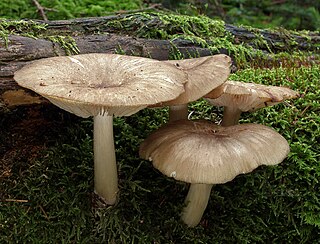Related Research Articles
Crinipellis sarmentosa is a species of fungus in the family Marasmiaceae. It is a plant pathogen.

Moniliophthora perniciosa is a fungus that causes "witches' broom disease" (WBD) of the cocoa tree T. cacao. This pathogen is currently limited to South America, Panama and the Caribbean, and is perhaps one of the best-known cocoa diseases, thought to have co-evolved with cocoa in its centre of origin.
Marasmiellus cocophilus is a species of fungus in the family Marasmiaceae. It was described as new to science in 1969 by mycologist David Pegler. The fungus causes lethal bole rot of coconut.

Collybia is a genus of mushrooms in the family Tricholomataceae. The genus has a widespread but rare distribution in northern temperate areas, and contains three species that grow on the decomposing remains of other mushrooms.
Cymatellopsis is a genus of fungus in the mushroom family Marasmiaceae. This is a monotypic genus, containing the single species Cymatellopsis ilmiana, found in east Africa.

Gymnopus is a genus of fungus in the family Omphalotaceae. The genus has a widespread, cosmopolitan distribution and contains about 300 species.

Macrocystidia is a genus of fungus in the mushroom family Marasmiaceae. The genus contains five species that collectively have a widespread distribution.
Lecanocybe is a genus of fungus in the mushroom family Marasmiaceae. This is a monotypic genus, containing the single species Lecanocybe lateralis, found in Java and Hawaii.

Megacollybia is a genus of fungus in the family Marasmiaceae. Previously thought to be monotypic, the genus was split into several species on the basis of genetic data in 2007. The type species, M. platyphylla, is restricted in distribution to Europe, Scandinavia, and western and central Russia. M. rimosa was described as new to science from Brazil in 2013.
Metulocyphella is a genus of fungus in the family Marasmiaceae. The genus contains two species found in South America.

Moniliophthora is a genus of fungi in the family Marasmiaceae. The genus was described in 1978 with M. roreri as the type species. This fungus, formerly known as Monilia roreri, causes frosty pod rot, a serious disease of Theobroma cacao.
Nochascypha is a genus of fungus in the family Marasmiaceae. The genus contains six species found in South America.
Phaeodepas is a genus of fungus in the family Marasmiaceae. The genus contains two species found in Venezuela.
Neonothopanus nambi is a poisonous and bioluminescent mushroom in the family Marasmiaceae. The genetic and molecular mechanisms underlying this species' bioluminescence were published in 2019, the first to be elucidated for a fungus. In 2020, genes from this fungus were used to create bioluminescent tobacco plants.

Marasmius elegans, commonly known as the velvet parachute, is a species of fungus in the family Marasmiaceae. It has a reddish-brown cap, and a whitish stipe with white hairs at the base. It can be found in eucalypt forests in Australia.
Neocampanella is a genus of fungus in the family Marasmiaceae. The genus is monotypic, containing the single species Neocampanella blastanos.
Cymatella is a genus of fungus in the family Marasmiaceae. The genus contains four species found in the Antilles.

Campanella is a genus of fungi in the family Marasmiaceae. The genus has a widespread distribution, especially in tropical regions, and contains about 40 species.

Crinipellis zonata, commonly known as the zoned Crinipellis or the zoned-cap Collybia, is a species of gilled mushroom in the family Marasmiaceae. Though considered a little brown mushroom of unknown edibility, it is distinctive because of its thick covering of coarse hairs, and differentiated from other members of Crinipellis by its slightly larger cap size, which reaches up to 25 mm (1.0 in) in diameter. The white gills on the underside of the cap are crowded closely together, and are free from attachment to the stem. Saprobic, it grows on the dead wood of deciduous trees from late summer to autumn. The fungus is found commonly in eastern North America, but has also been collected in Portugal and Korea. The variety C. zonata var. cremoricolor, found in eastern North America, may be distinguished microscopically by its longer spores.

Marasmius sasicola is a species of Marasmiaceae fungus known from Kanagawa Prefecture, Japan. First collected in 2000, it was described in 2002 by Haruki Takahashi. The species produces small mushrooms with white caps and very short, very thin black stems. Unlike in other, similar species, the stems enter the plant matter on which the mushroom grows. The six to eight white gills are spread out around the cap, and all of them reach the stem. The flesh has no taste or odour. Found in June, the species grows on dead Sasa leaves, from which it takes its specific epithet.
References
- ↑ Antonín V, Ryoo R, Shin HD (2009). "Marasmioid and gymnopoid fungi of the Republic of Korea. 1. Three interesting species of Crinipellis (Basidiomycota, Marasmiaceae)". Mycotaxon. 108: 429–40. doi:10.5248/108.429.